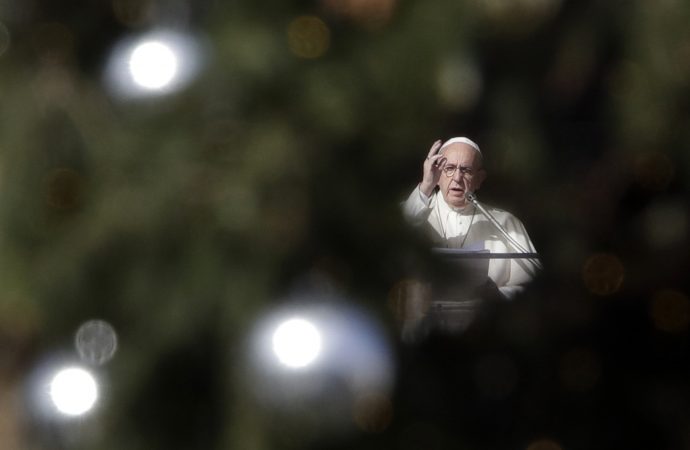While much of the world is preparing to take a step back from the rapid pace of everyday life during the holiday season, Pope Francis is getting ready for his typically packed Christmas schedule, including some of the most important and intimate moments of the year for both the Vatican and the Catholic Church.
The start to the busy season is the pope’s annual speech to members of the Roman Curia, which this year is set to take place Friday, Dec. 21. During his papacy, the address, rather than reflecting the tender caress of a loving father of which Francis so often speaks, has become a prime opportunity for a dose of pontifical “fraternal correction.”
In 2014, about a year and a half after taking office, Francis offered a searing critique of what he said were 15 “spiritual ailments” infecting the curia. Of these 15 “illnesses,” the pope diagnosed what he called “spiritual Alzheimer’s,” meaning “a progressive decline in spiritual faculties” leading people to build walls around themselves and turn their personal habits into “idols.”
He also called out what he said was an “existential schizophrenia” prone to hypocrisy and leading people to live a “double life.” Such schizophrenia, he said, is a sickness which “often strikes those who, abandoning pastoral service, limit themselves to bureaucratic activity, thereby losing contact with reality and with concrete persons.”
In past years he also took the opportunity to highlight a play-by-play of curia reform efforts, providing in 2016 a 12-point list of guiding principles for his vision of reform, centered largely around the need for personal conversion, a shake-up of personnel, and an updating of archaic structures.
However, in last year’s speech, the pope did not seem optimistic about the progress of reform, saying efforts were being thwarted by “betrayers of trust”. Quoting the famed 19th century Belgian papal statesman Frédéric-François-Xavier De Mérode, he added that “implementing reforms in Rome is like cleaning the Egyptian Sphinx with a toothbrush.”
This year, with much attention turned to the clerical sexual abuse scandals that have rocked Chile and the United States, in particular, and especially in light of accusations by a former papal ambassador to the U.S. that Pope Francis covered the sexual misconduct of a high-profile American cardinal, this year’s speech will perhaps be his highest-stakes address to the Roman Curia to date.
After his speech to the Curia, Francis will celebrate Christmas Eve Mass Dec. 24 in St. Peter’s Basilica, and on Christmas day he will offer his traditional Urbi et Orbi (“to the city and the world”) which, despite the jovial nature of the Christmas season, has typically served as an opportunity for the pope to highlight areas of suffering and conflict in the world. Although it contains prayers, it’s also a policy speech in that it serves to highlight the diplomatic priorities of the pope and his Vatican team.
On Dec. 26, the Catholic feast of St. Stephen, the Church’s first martyr who was stoned to death for confessing his belief in Jesus Christ as the Messiah, the pope will recite the Angelus prayer with faithful in St. Peter’s Square, likely focusing on the topic of modern-day martyrdom – a topic he has been outspoken about, and which is also among the social priorities of his papacy.
Closing out the year, Francis will pray Vespers in St. Peter’s Basilica on the eve of the feast of Mary, Mother of God, the first Catholic feast of the new year. During the evening prayer service, Francis will lead attendees in Eucharistic adoration and the singing of the “Te Deum” – a hymn of praise to God offering thanksgiving for the year that is ending.
Also on New Year’s eve, the pope will come out to St. Peter’s Square in the evening to visit the Vatican’s nativity set, which this year is made entirely of sand. Afterwards, he’ll greet the working staff of the Vatican City State, in one of the most directly pastoral moments of the papal year.
The next day, Francis will celebrate Mass for Mary, Mother of God – one of the most important Marian feasts on the liturgical calendar – on Jan. 1, which also marks the international World Day for Peace, this year with the theme, “Good politics is at the service of peace.”
On Jan. 6 Francis will keep the Christmas spirit going by celebrating Mass in St. Peter’s Basilica marking the feast of the Epiphany, commemorating the visit of the “three wise men,” who brought the infant Jesus gifts of gold, frankincense and myrrh. The day also happens to be the vigil of Christmas on the Julian calendar followed by much of the Eastern Orthodox Christian world.
Shortly after that, around Jan. 7 the pope will give his annual speech to the diplomatic corps accredited to the Holy See – a speech which, while usually not overly provocative, sets the tone for Vatican diplomacy throughout the year, and provides ambassadors a key opportunity to meet and exchange small talk with the pope.
Closing the holiday liturgies, Francis will celebrate Mass for the feast of the Baptism of the Lord on Jan. 13 inside the Sistine Chapel, during which he always baptizes several infants and delivers an off-the-cuff homily to parents encouraging them to raise their children with faith and tenderness.
Francis will then head to Panama for the Jan. 23-28 international celebration of World Youth Day, starting a new season for him this coming spring – a season of travel. With four international trips already on the horizon before the end of May, the pope’s busy schedule is not likely to end with the Christmas season, but could set the tone for all of 2019.

